Introduction
There are two types of elephant in Uganda: the endangered bush or savannah elephant (Loxodonta africana) and the smaller and critically endangered forest elephant (Loxodonta cyclotis). The forest elephant is mainly found in west and central African jungles but a few have made their way to Bwindi Impenetrable Forest from the Democratic Republic of Congo (DRC).
The African bush elephant is found more widely across Uganda, but mainly in Kidepo, Murchison Falls, Semuliki, and the Greater Virunga Landscape.1https://uganda.wcs.org/Wildlife/Elephants.aspx There are approximately 415,000 African bush elephants and African forest elephants alive today, declining by 111,000 since 20062https://www.iucnredlist.org/species/181008073/223031019#population across 37 different African countries.3https://animalia.bio/african-bush-elephant There were last reported to be 5,000 African elephants in Uganda,1https://uganda.wcs.org/Wildlife/Elephants.aspx but due to conservation efforts and the migration of elephants from war-torn DRC, where they are also heavily poached, this number has increased in the last 10 years.4https://www.awf.org/sites/default/files/2022-08/2022%20Elephant%20Conservation%20Progress%20Report.pdf Some put estimates nearing 8,000 today.5https://animalsurvival.org/trade-and-legislation/elephant-and-rhino-numbers-rising-in-uganda-after-years-long-poaching-wave/
Fascinating facts
A gentle giant
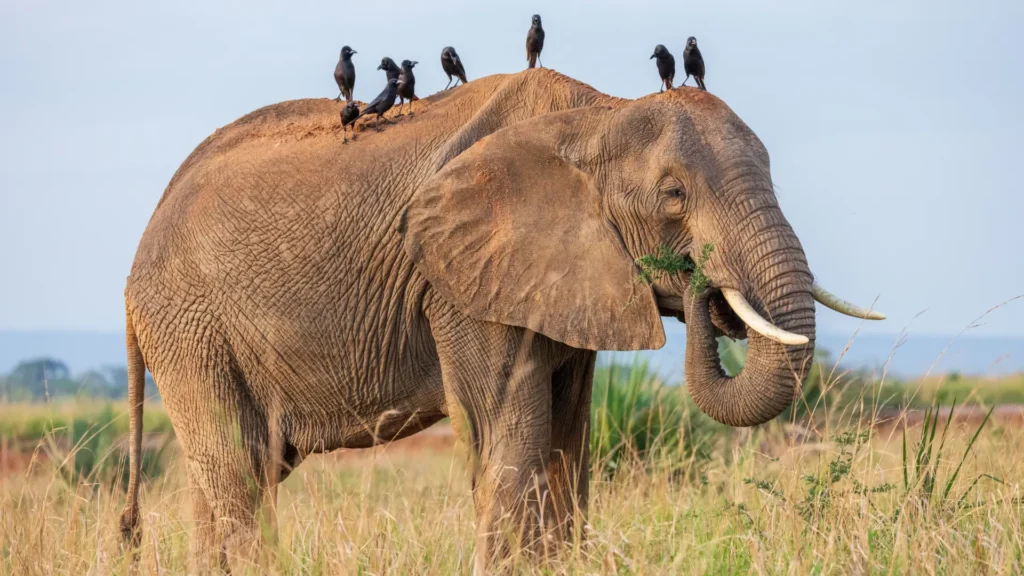
The African bush elephant is not only the largest elephant, but the largest land mammal on Earth. An adult male can be almost 10 feet (three metres) tall and tip the scales at 945 stone (6,000 kg). Even smaller males rarely weigh less than 630 stone (4,000 kg).6https://destinationuganda.com/animals/african-elephant/ At birth, calves can weigh an impressive 19 stone (120 kg).7https://www.wwf.org.uk/learn/fascinating-facts/elephants
Mum knows best

Elephants live in matriarchal societies, led by older females (cows). Male elephants (bulls) usually live in ‘bachelor herds’ looking out for females to mate with. A bull can tell if a female is ready to mate by her smell and, if he beats off the competition, will stay with the female and her herd for two weeks during this time.8https://www.britannica.com/animal/elephant-mammal/Reproduction-and-life-cycle
Even more to the male than meets the eye
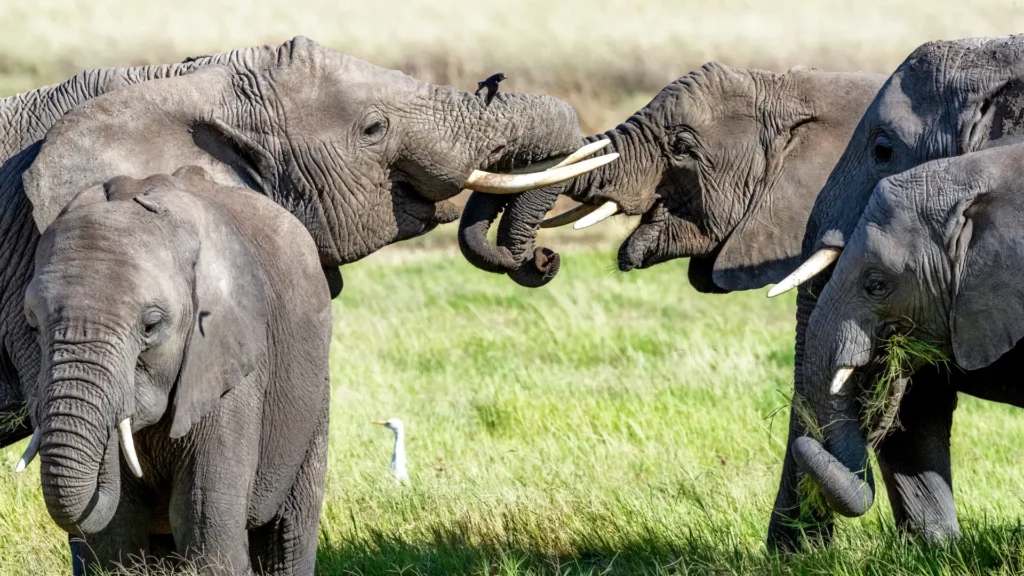
It was long thought that the matriarchal herds were where knowledge was passed to the young. However, recent research highlights how older male elephants (bulls) are essential in keeping juvenile males’ behaviour in check and in passing on years of experience to young males of, for example, where to find the best fruiting trees and water.9https://www.nature.com/articles/s41598-020-70682-y
Elephants have the longest pregnancy of all animals

A female is pregnant for 22 months before giving birth to one calf. After just five minutes the calf is able to stand and after one hour they can walk. The mother suckles the calf for the first two years of their life, and the whole herd protects them until they are six years old and can care for themselves.
Elephants are long-lived

Elephants are one of the longest-living land mammals alongside humans, and can reach the ripe old age of 80 years old. Currently, the world’s oldest elephant is an Indian elephant called Vatsala, who is over 100 years old.
Elephants are emotional animals
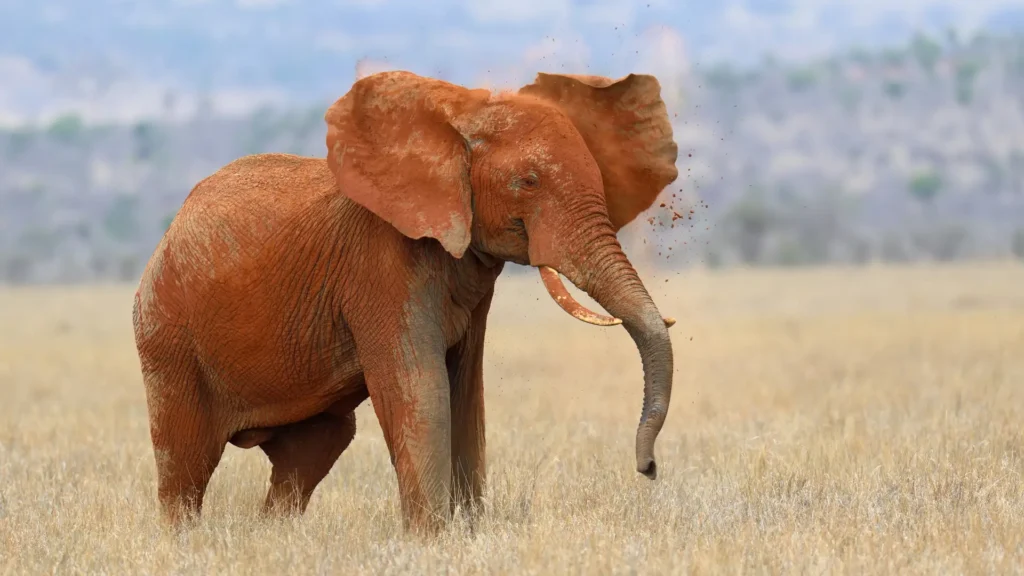
Elephants lead rich and complex emotional lives. They take care of weaker individuals, adopt and look after orphaned calves, and mourn their dead.1https://uganda.wcs.org/Wildlife/Elephants.aspx An elephant’s brain weighs almost one stone (six kilograms) and their temporal lobe – the bit that deals with memory – is larger and denser than a human’s.7https://www.wwf.org.uk/learn/fascinating-facts/elephants
A trunk has many uses

An elephant’s trunk is a very long nose but it can do a lot more than just smell. It has no bones but is made up of 40,000 muscles – an entire human body only has 600 muscles! Elephants use their trunk as an arm to touch and comfort their young and to greet friends. They can use it to grab branches and place food in their mouth, and to suck up water and spray it into their mouth – or on to others! Juvenile elephants have been filmed spraying each other and antelope and zebras, just for fun!
Elephants use their trunk to perform a range of important communication gestures, from raising it high to signal a threat and swinging it from side to side to warn off a predator.10https://www.bornfree.org.uk/news/why-do-elephants-have-trunks-and-what-are-they-for/ By placing the tip of their trunk on the ground, elephants can also use it to sense vibrations so they could feel a predator approaching before it is visible.10https://www.bornfree.org.uk/news/why-do-elephants-have-trunks-and-what-are-they-for/
Elephants have an elephant-sized appetite

Elephants munch through nearly 22 stone (140 kg) of roots, grasses, fruit and bark every day.11https://www.nationalgeographic.com/animals/mammals/facts/african-elephant They need to eat so much to sustain themselves that they only sleep for four hours a day, instead slowly roaming across the land in search of food.
Elephants have an important role in the ecosystem
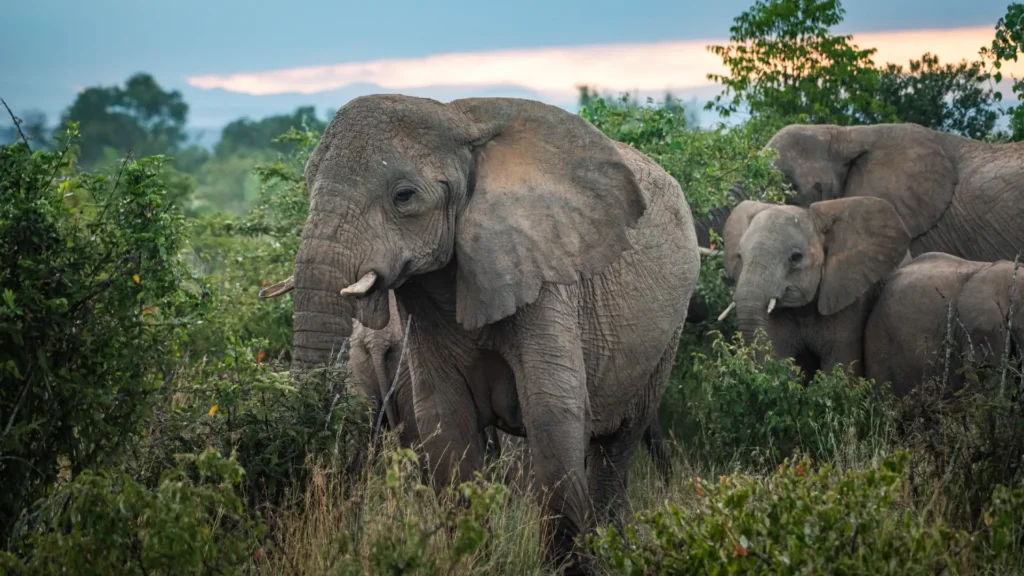
They help maintain open grasslands by removing tree and thorn bush cover, create ponds and wallowing holes by digging for water and helping it reach the surface, and they help disperse the seeds of the trees they feed on in their manure.
Tusks are big teeth
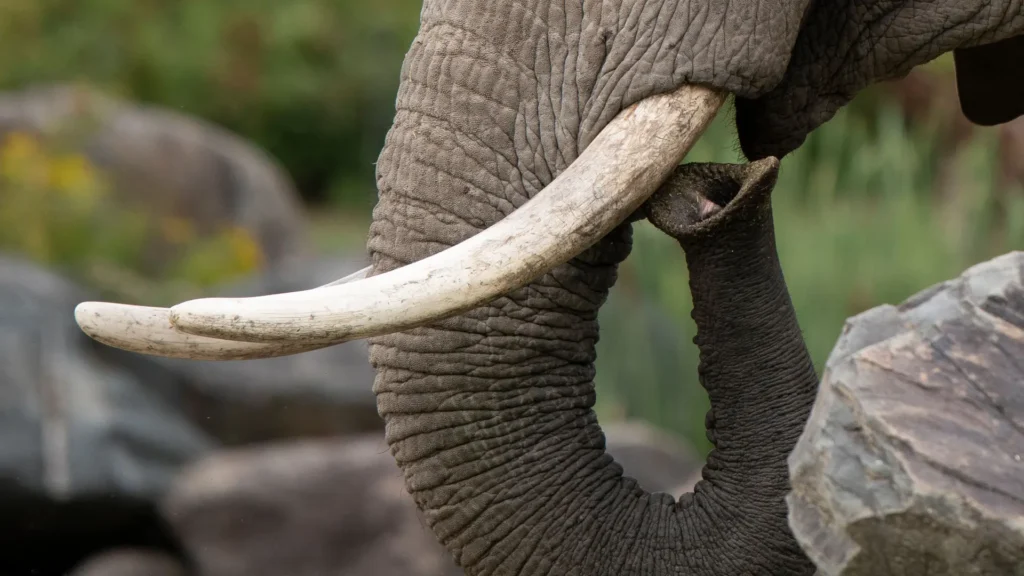
Both male and female elephants have tusks, but the males grow faster than the female’s. Tusks begin to grow when the young elephant is between one and three years old from teeth called tushes.3https://animalia.bio/african-bush-elephant The tusks grow throughout the elephant’s entire life and can reach over six foot (two metres) in length and weigh four stone (23 kg).12https://www.britannica.com/topic/ivory
Threats to African Bush Elephants
Habitat loss

In Uganda, habitat loss is the biggest threat to African bush elephants. As the human population increases, more land is converted into settlements and farmland, and fragmented by roads. What’s more, huge amounts of oil have been found under Murchison Falls, Uganda’s largest national park and despite worldwide opposition by conservationists, French oil company TotalEnergies began drilling in the park in 2023.13https://www.afrik21.africa/en/uganda-totalenergies-begins-drilling-for-oil-in-the-murchison-falls-national-park/
Fifty years ago, Uganda’s elephants could freely roam across the country but today they have become isolated in parks and reserves, cut off from each other by human developments. It is becoming harder and harder for elephants to find enough food to sustain themselves in their restricted and diminishing environment.
Human-wildlife conflict
As habitat loss reduces the amount of available food for the elephants, they have to take matters into their own trunks. With no other way to get enough food, elephants have started raiding nearby farms to eat the crops. Unfortunately, due to their size, not only do the elephants eat the crops, but they also end up trampling on them and damaging the surrounding growth.14https://www.overandaboveafrica.com/elephant-bee-project-uganda If humans try to scare off or stop the elephants, they risk being seriously injured.15https://animaldiversity.org/accounts/Loxodonta_africana/#economic_importance_positive
Because the local communities rely on these crops for survival, many view the elephants as a pest and would rather they were totally eliminated from the area. This emphasises the importance of community projects to educate the locals about the role of the elephants in the ecosystem, help them appreciate the beauty of the animals, and above all, find ways for both the local people and the elephants to peacefully coexist. For the local people, their main concern is having enough food and money to support their family so creating a more stable economy through community tourism is essential.
Poaching
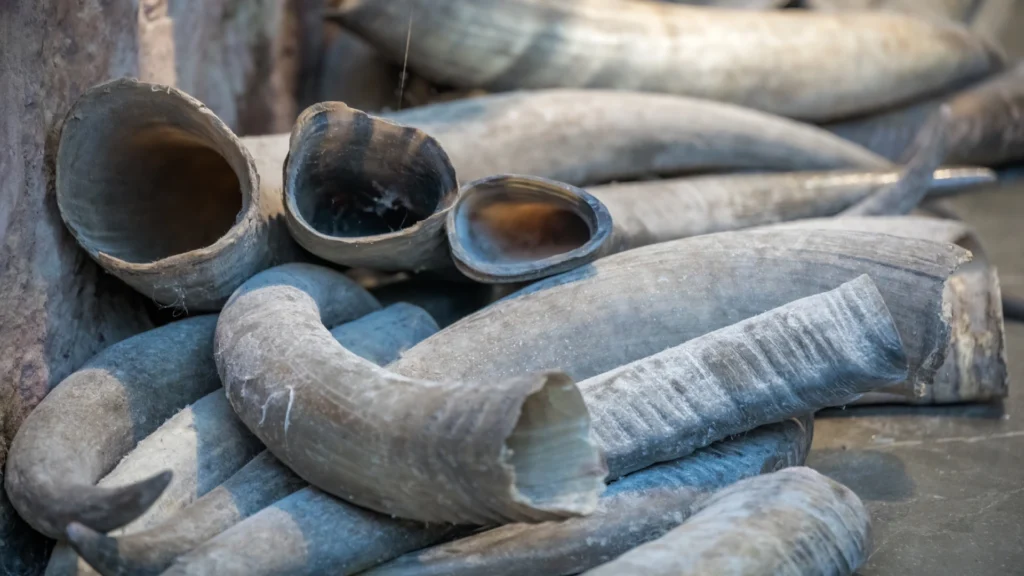
Globally, poaching is the biggest threat to African bush elephants and it poses a significant threat to Uganda’s bush elephants too. Elephants have been hunted to near extinction because of human greed for their ivory. Throughout history, elephants have been hunted and had their tusks violently hacked off to be turned into luxury items such as piano keys, chopsticks, tea sets and jewellery. Ivory has also been called “the white gold of jihad” because the illegal trade of this body part has funded extremist terrorist groups.1https://uganda.wcs.org/Wildlife/Elephants.aspx
Poachers usually gun down the elephants with AK-47s, or attack them with a poisoned spear. Neither of these methods immediately kill the elephant, so the poachers will then slice the elephant’s leg tendons to immobilise them and then slash the trunk so the elephant bleeds to death. It is slow, gruesome and traumatising for the whole herd of emotionally intelligent beings.
Today, ivory trading is banned in most countries but there is still demand in East and Southeast Asia16https://www.fauna-flora.org/explained/a-guide-to-ivory-trade/ and around 20,000 elephants are killed every year for their ivory.17https://www.worldwildlife.org/initiatives/stopping-elephant-ivory-demand Although the Chinese government actually banned the sale of ivory in 2017, the most demand for ivory still comes from China.18https://www.worldwildlife.org/magazine/issues/winter-2018/articles/why-do-people-buy-elephant-ivory Because of weak law enforcement in Uganda, it is the main country used to smuggle illegal ivory out of Africa, even if most aren’t killed there.1https://uganda.wcs.org/Wildlife/Elephants.aspx Between 2016 and 2021, 256 kg of ivory was seized coming out of Uganda.4https://www.awf.org/sites/default/files/2022-08/2022%20Elephant%20Conservation%20Progress%20Report.pdf
The rangers in Uganda’s national parks patrol day and night to defend the elephants, and all the animals, against poachers. Since the outbreak of Covid-19 and its negative effect on the economy, poaching in Uganda intensified as people became more desperate to find ways to make money. Juma Mohammed, a ranger in Murchison Falls National Park, said that if the rangers let up, the poachers will take over.19https://www.unep.org/news-and-stories/story/frontline-against-wildlife-poaching-uganda This shows that the future of the elephants in Uganda is balanced on a knife edge, and we must do all we can to support the work of rangers, putting their lives on the line for the wildlife they protect.

References
References
- 1
- 2
- 3
- 4
- 5
- 6
- 7
- 8
- 9
- 10
- 11
- 12
- 13
- 14
- 15
- 16
- 17
- 18
- 19

